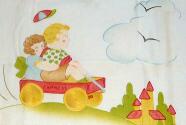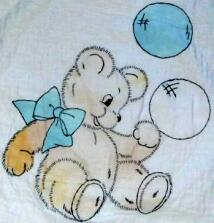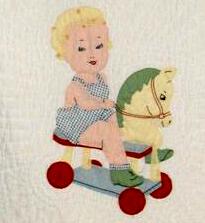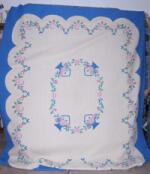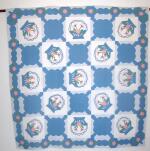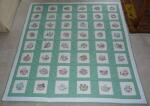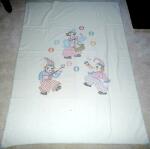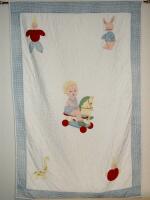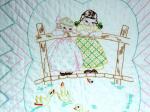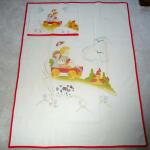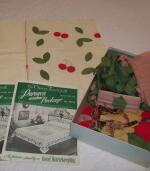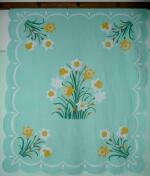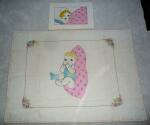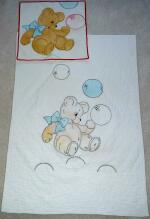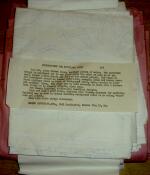History of Kit Quilts
Judi Fibush is a quilt historian and restoration professional who developed the following presentation study on Vintage and Antique Kit Quilts. Any comments or corrections can be sent to
The 1970’s restarted a large interest in quilts and quilt making. Antique and vintage quilts came out of the closets and modern women came to realize what treasures had been lurking in an everyday essential as a bed covering. However, as these beauties surfaced, it was also noted that many were not individual or original creations but some were made from KITS!
HORRORS! Thought some of the notable quilt authorities at that time (some still feel that way today). After all quilt kits according to them were not very creative in that they could be replicated by anyone and were more common to see, were easy to make (not by a long shot, especially the appliqué ones) and were rather mundane. Fortunately they have been proven very wrong on most accounts. Kit quilts encouraged women to quilt who felt that they didn't have enough creativity to tackle a quilt all on their own.
Today the designers and manufacturers of the quilt kits of bygone years are viewed with delight and are proving to be quite valuable. eBay of the 1990’s certainly brought them into the public’s eye and helped make them very costly.
The Centennial Exhibition of 1876 in Philadelphia, PA, started the Arts and Crafts movement in both architecture and home décor changing from the elaborate designs of the Victorian age to simpler styles of an earlier time. Think about the fussy and time consuming examples of the crazy quilts, which were seldom ever practical or used, to the beauty of the pieced block quilts. Hence the start of the Colonial Revival Quilts which were not a particular style but a change in wanting life to be less ostentatious and more useful.
Quilt kits came into popularity and vogue in the 1920’s and 30’s although some date back to the late 1800’s. Some are still being produced by companies today. The kits were aided in production due to increase in printing of periodicals and mass advertising.
The kits of the 1920’s and 30’s came in various fashions; prestamped cloth pieces to be appliquéd onto stamped backgrounds, cross stitch or embroidery stamped patterns, sets of prestamped blocks to be assembled into a quilt, and precut pieces to assemble. Some of the earlier kits had perforated patterns that came with a powder or paste to use for stamping. Eventually the prestamped blue lines were used almost exclusively for not only the patterns but for the quilting lines too.
The most notable individual designers, companies and stores/catalogs who sold them are briefly described below with notations of websites to peruse. Many may not be shown due to the lack of information available on some and the lack of knowledge on the part of this author.
Individuals
A brief discussion about Anne Orr, Hurbert Ver Mehren and Marie Webster as individuals follows. Others of note are Marion Cheever Whiteside Newton who did Story Book Quilts, Carlie Sexton, Ruby Short McKim and Mary A. McElwain. Uncoverings from AQSG have more info on these 4 women.
Anne Orr - 1869-1946
Anne Orr - 1869-1946 She started her own business called Anne Orr Studios and wrote for Southern Woman’s Magazine, designed for J & P Coats Thread Co. and wrote a column in 1919 for Good Housekeeping until she retired in 1940. Her business employed over 100 people making patterns, transfers, and some 80 quilt designs/kits which were pieced, appliquéd and even some whole cloth quilts. They also made other needlework designs and some were engaged in basting and/or finishing quilts too. Most of her appliqued quilts were floral designs and she favored scalloped or notched edges. (Please click on a picture for a larger view.)
The Garland Quilt was offered as a hot-iron transfer and as
kit #123 for $8.75. More
details can be seen at
www.intatters.com/content.php?98-History-Anne-Orr
Ruby Short McKim - 1891-1976
Ruby Short was born in Millersburg, IL in 1891 to Morris T., a frontier missionary, and Viola Vernon, a teacher. Ruby showed an early interest in drawing, carrying a sketchbook with her everywhere she went. After graduating from High School in 1910, her uncle sponsored her studies at the New York School of Fine & Applied Arts, now known as Parson’s, The New School for Design. She graduated in 1912, with her diploma signed by Frank Alvah Parsons, himself. Ruby then became the Supervisor of Drawing for the Independence School District, and a very popular teacher among the students. In 1916, she taught at Manual Training High School in Kansas City, MO.
Henry Holt and Company, a New York publishing firm, launched a series of children’s stories about small woodland animals written by author Thornton Burgess. Ruby Short was chosen as the winner of a contest held by the Kansas City Star to design a quilt pattern for children which would be published in the paper. Her “Quaddy Quiltie” linear quilt blocks were published in the Kansas City Star newspaper as a promotion that was co-copyrighted with the author. This was her first, and probably most famous of the quilt series. The Star started publishing quilt patterns in 1928 and Ruby was their designer for 3 years.
In 1917 she married Arthur McKim, a public relations businessman and they had 3 children – Betty, Marilyn and Kim. In 1922 she became the Children’s Art Editor of a new publication, Child Life Magazine, a magazine which included quilt patterns and needlework projects for children, and stayed with them into the 1930s. Ruby and Arthur started in 1928 McKim Studios a home-based mail order business offering needlework supplies and patterns. She also designed for Women’s World magazine in 1931 which offered her patterns on pre-stamped kits by mail order i.e.: Jolly Circus Quilt, Child Life Quilt, Alice in Wonderland and many others. In 1931 she published One Hundred and One Patchwork Patterns. All 101 patterns are free to download, and the valuable text can easily be printed. If interested go to www.101patchworkpatterns.com.
In 1935, McKim Studios became Kimport Dolls which was a catalog of foreign, Kimport-made, or antique dolls offered via mail-order to customers worldwide.
Ruby passed away in 1976 but had the honor of being included in the early 1980s, 2nd edition of Who’s Who Among American Women. She was also inducted into the Quilter’s Hall of Fame in 2002. She combined her vocation with marriage and family; she was a woman ahead of her time.
Hubert Ver Mehren - 1892-1971
Hubert was a talented male designer (in a world dominated by women designers) of pre-stamped designs which were sold thru catalogs when he was involved in his family’s business the Ideal Button and Pleating Co. in Omaha, NE. When he married Mary Jacobs, he was making embroidery items for the People’s Popular Monthly magazine in IA.
In 1930, he and Mary formed their own home business called the Home Arts Studio with two catalogs under Mary’s name only. These two catalogs were Colonial Quilts and Hope Winslow’s Quilts. (Note: Hope Winslow was not a real person and the picture of her on the catalog is still a mystery as to who she was.) His name hardly appeared on anything and only in later years would he identify his design with his initials H.V.M. They made ready cut quilts with patterns/pieces stamped on the fabric as well as appliqué and embroidery. He used perforated quilting designs and sold stamping wax, stamping powder and yellow carbon paper to mark the patterns.
Hubert was noted for his large medallion quilts with a center motif: i.e., Lone Star, Giant Dahlia, etc. He also did some rather complicated border designs that were too difficult for even the most experienced quilt makers. His Iowa Button and Pleating business continued doing embroidered pieces and monograms, pennants and flags. He died in 1972 overcome by carbon monoxide poisoning in his apartment above his business.
Marie Webster -1859-1956
Marie was a quilt designer, business woman and author. She wrote the first American book on quilting Quilts, Their Story, and How to Make Them was first published in 1915 and the latest edition came out in 2009. She was inducted into the Quilters Hall of Fame in 1991 and her home in Marion, IN is now the home of the Quilters Hall of Fame and a National Historic Landmark.
Her patterns were all appliqué and mostly done in pastels as she was inspired by the Arts and Crafts Movement of the early 1900’s. She formed her own company with her sister and two friends called The Practical Patchwork Company. They made patterns with instructions and fabric as well as partially completed quilts and shipped them all over the US.
More details at: en.wikipedia.org/wiki/Marie_Webster
Companies
Aunt Martha/Colonial Patterns, Inc.
Jack and Clara Tillotson of Kansas City, MO started their own company in 1930 selling quilt kits. They called it the Colonial Readicut Quilt Block Co. and published a catalog containing 100 quilt designs. The kits did not sell well but the patterns were in demand. They renamed their company Colonial Pattern Company and used the name “Aunt Martha” to sell their patterns in magazines and newspapers. They sold the quilt pattern section of their business to the Swensons in 1949 who changed the name to Aunt Martha’s Studios and continued to sell readicut star quilt kits as well as embroidered kits and patterns. The company was sold again in 1974 to Edward Price who changed it to the present day name of Colonial Patterns, Inc. and who continues to sell Aunt Martha items today.
There are numerous websites for Aunt Martha and Colonial Patterns, Inc. on Google and too many to notate here.
Bucilla
Bucilla is an acronym for Bernhard Ulmann Inc. founded by the man with the same name in 1867. He originally sold silk screened hankies and linens from a pushcart in NYC. He opened a store in 1870 and then went on to sell to retailers in 1875. He developed a high quality yarn called Mellina and it became so popular that he branched out to selling various items for knitting, needlepoint and embroidery as well as publishing books and patterns for needlework items. The company was owned by the family until 1922 when it was sold off to the employees. It then went on to be bought and sold by Indian Head Corp., then Hannson Trust, then Armour Dial a division of Greyhound Corp and finally in 1996 to Dyson-Kissner-Moran Corp which placed it under Plaid Enterprises which still is its owner today. From 1923-1994 at least 225 kits were known to be issued. Bucilla continues to make needlecraft items being sold today in Jo-Ann, Michael’s, etc. stores.
More details can be found at: www.plaidonline.com/the-history-of-bucilla/542/article.htm
Fairway Needlecraft Co.
Fairway Needlecraft co. is a family owned business that was started in 1918 by grand father Frank and his brother Otto Ulrich. They manufacturer many items for embroidery: quilt blocks, quilt crib tops, pillowcases, table cloths, queen size quilt tops, etc. Anything that can be embroidered for crafts they manufacture. They started in the family house, graduated to buildings on the farm and then moved in a bigger building away from the farm. Norman, Frank’s son and his sons, Jim and Ron run Ulrich and Associates which also includes Hillcrest Farm. Today they are still in business in St Claire, Mo. with several generations working and running the business. Norman was in charge of sales and the chief designer. Although he started designing the patterns by hand with just a light table he used a computer until his death in 2005. A latex gel in color is used to transfer the design on to the fabric. Fairway is strictly a wholesaler. Their products are sold through the distributer NOJAE of Fairway in stores such as: Jo-Ann, Ben Franklin, True Value, VNS variety stores, etc. You may find the word NOJAE in the selvage on some items.
More details at http://fairwayneedlecraft.com/zencart
F.A. Herrschner Company
Frederick A. Herrschner started his company in 1899 by selling embroidery patterns and sewing items from a pushcart in Chicago. His products were popular (floss, embroidered items, sewing notions, baby items, ladies lingerie, etc.) and when his customers moved away they asked him to mail items to them. He then started a mail order catalog company selling his patterns and DMC floss from France. Stamped and perforated patterns were the only items in his 1923 catalog. Since he did the patterns as they were ordered, he encouraged his customers to do their own stamping using the perforated patterns. His first quilt kits were shown in 1927 catalogs but half of his inventory was clothing. Some kits were in the catalogs in the 1930’s but most of his kits were sold by others: i.e. Bucilla, Paragon, Progress, etc.
Frederick Sr. died in 1932 and then his son (Jr.) took over. The company sold about 400 different quilt products from 1920 – 1970’s but also branched out to kits for leather, beading, jewelry, textile painting, doll kits, etc. They are still in business in Stevens Point, WI and put out a 100 year anniversary catalog in 1999.
More details at www.herrschners.com
HomeNeedlecraft Creations
The Homecraft Creations name preceded Home Needlecraft Creations and was just a name change. It was then bought by Gold Art which became Homecraft Creations but no documentation exists. A lot of similar patterns, markings and packaging look the same as the original Home Needlecraft Creations. There is speculation that Lee Wards may have bought what was left of Gold Art and Homecraft Creations because the packaging were very much alike from both companies. They both used tan envelopes to enclose the prestamped fabrics including placement of appliqué pieces and quilting lines with other items to make the kits. On the front of the envelopes was a drawing of the finished quilt plus simple instructions and what color floss to purchase for the embroidery details.
Jack Dempsey/JayDee
Since 1949, Jack Dempsey Needle Art has been selling patterns and kits for embroidery items in quilts, baby items, pillow cases and other keepsakes. They do make prestamped crib cover tops to be embroidered but no quilting lines are included. Today they are located in St Louis, MO and continue to be a leader in the industry. I had several occasions to call the company and talked to Rhonda who was extremely helpful in identifying two of my crib quilts as their designs and knew a lot about the history of the company
More details at www.jdneedleart.com/about-our-company.html
J.B.K. Co
Very little is known about this company except that Vogart/Vogue Needlecraft made the hand tinted quilt covers and pillow covers. They are distinguished from Vogart colors due to the lime green and dark gold that was only used in their products. J.B.K.’s kits were sold thru S. S. Kresge’s stores in the 1930’s. The J.B.K. trademark appeared in Kresge’s catalogs during the 1920’s and 30’s. They sold many linens and pillow panels called Sport Pillows. Kresge’s changed their name to Kmart in 1977.
LeeWards Stores and Catalogs
Sidney Fink and Ralph Fried opened Leeward Products LTD in Chicago, IL in 1947. In 1948, they changed the name to Dexter Thread Mills Inc. not to be confused with Dexter Mills, Inc. In 1950 the added a catalog division called LeeWard Mills and sent out 25,000 catalogs. LeeWard Mills became LeeWards in 1956 and opened up their first store in 1962 in Elgin, IL. They were bought by General Mills in 1969 and finally bought by Michaels in 1994 to add to Michaels billion dollar chain.
The company did not make original designs but sold yarns, craft items, quilt kits from various companies listed here and must be added due to their mass marketing and selling of quilt kits, fabrics, floss, etc.
Paragon Needlecraft
Paragon made 127 kits from 1937-1982 and are still making kits today. Little is known about Paragon Needlecraft except that it was in business for 60+ years selling quilt kits and different kinds of needlecraft kits thru stores such as: J.C. Penny, Sears, Macy’s, etc and catalogs, especially thru Lee Wards. The following is taken from an online site about National Media Corporation which is headquartered in Encino, CA.
“Media Arts International, based in Phoenix, Arizona, was one of the first companies to produce infomercials in 1984. In November 1986 Media Arts International was acquired by National Media Corporation, then known as National Paragon Corporation, for $4 million, as part of National Paragon's approved reorganization plan. Prior to entering the infomercial business, National Paragon Corporation was engaged in the needlecraft business for more than 60 years. In 1984 it formed National Syndication, Inc., a subsidiary that managed a variety of specialty catalogs and mail-order businesses. In October 1985 National Paragon filed for bankruptcy protection under Chapter 11 of the Bankruptcy Reform Act. A year later it emerged from Chapter 11 and in November 1986 acquired Media Arts International as part of its approved reorganization plan.”
Progress
Even less is known about the history of the Progress quilt kit company although they produced some of the most and best full sized quilt kits known. All were done on various colored backgrounds from white, yellow, green, pink and blue with prestamped appliqués of flowers, leaves and swags in many colors.
Many of their crib kits used a variety of colored gingham fabrics exclusively in their appliqued figures. All blue quilt lines were prestamped too. Some 135 kits including embroidery quilt kits that were produced from 1923-1994 have been documented. A great deal sold thru Lee Wards and other catalogs and stores. Progress was bought by Tobin, Sporn, and Glaser Inc.in 1944 when they were in business in Chicago. They still are in business today but out of New York.
Rainbow Quilt Block Company (RQBC)
William B, Pinch started the company in the 1920’s in Cleveland, OH. His very early designs were called So-Mor and featured stamped colored embroidered and appliqued quilt blocks. He was a professional photographer who loved art and design and created more than 1000 designs. His products were sold in department stores and magazines in the 1930’s and 40’s and now are sold online thru their website. The products included single quilt blocks to total kits with appliqué and embroidery done on fabrics that were hand stamped with the designs. Their unique designs were done in color which was very unusual then and even today.
Royal Society/H.E. Verran Co.
Harry E. Verran (1869-1930), was born in Platteville, Wis. and headed the H. E. Verran Co., which manufactured embroidery from 1915 to 1928. Harry Verran moved to New York around 1900 and went to work for Charles E. Bentley at Bentley's lace and embroidery factory on lower Broadway. Around 1912 he bought the company, which then became "H. E. Verran Co., Art Needle Work." In the late 1920s Verran built a new factory in Stamford, Conn. and moved the company there. He changed the name to Royal Society which made mostly knitting and crocheting books but some quilt and pillow kits were produced in the late 20’s and 30’s. Also a series of kits for decorative laundry bags which looked like dolls were made. All their kits were packaged in tan envelopes with a colored picture of the finished product on the front. The kit included the prestamped fabric, floss and even a needle.
Vogart, Vogue Needlecraft Co., Kugel-Vogart and Vogart Crafts
This company was formed in 1912 by King Hearch in California and made prestamped items for pillowcases, doilies, etc to be sold in department stores. In 1930 the company was using the name Vogue Needlecraft Co., in NY. B. Kugel Co. bought it and changed the name to Vogart 1941. In the late 1960’s it was sold again to an unknown public company and then was renamed Vogart Crafts Corp. It went under in 1992 and was bought by Bucilla who was then bought by the Plaid Enterprises, Inc. in 1996.
Their products were prestamped items for embroidery on almost everything imaginable. But eventually they branched out to hoops, transfer patterns, paint books and tubes and kids kits. The stamped items were sold in large department stores and were individually designed for each store: i.e. F.W. Woolworth, G. C. Murphy, W. T. Grant, etc. In 1943, the Vogart Co. advertised that it ran inserts in 50 different newspapers and magazines for its embroidery patterns. Crib covers and matching pillow set kits started in 1935 and were shown in Herrschners and Woolworth’s catalogs. One of the most interesting is the Teddy with Bubbles set advertised in a Woolworth catalog in 1935 and marked as a N.R.A. (National Recovery Act) product. It is rare today to see any quilt with this marking and very seldom on just a crib set. More details at www.yellowzeppelin.net/vogart history.html
Wonder Art (Fixler Bros)
Fixler Bros, Inc. was founded in 1916 in Chicago and their trademark products were named Wonder Art. The prestamped goods were sold in department stores along with a free Book of Instructions which gave all the instructions and information for all their products. (Interesting concept so they didn’t have to do a separate set for each item.) An early Wonder Art kit consisted of a package with 6 designs printed on the package – 3 for appliqué and 3 for embroidery. However, each package only contained one 18 inch block so the consumer was required to buy multiple packages to make a quilt for a total of 20 packages for a quilt. The good news is they did sell for only 10 cents a package at that time but that might have been expensive then too. They also recommended using Perlene floss as opposed to DMC that most other companies used. The items were sold thru S.S. Kresge, J.J. Newberry, Scott Stores, G.C. Murphy. F.W. Woolworth, etc stores. There is not a date as to when Fixler Bros lost ownership of Wonder Art but it is now owned by Caron International, Inc in Washington, D.C.
Workbasket – (Modern Handcrafts)
“Workbasket” was a magazine published in 1935 by the husband and wife team of John and Clara Tillotson and lasted for 61 years. It had 16 pages printed on newsprint. It originally published quilt block patterns but also complete quilt kits. Recently a quilt kit appeared on eBay with a Snowflake pattern. The magazine was originally called "Aunt Martha's Workbasket, Home and Needlecraft, For Pleasure and Profit" and was issued by Modern Handcrafts of Kansas City, MO. Most issues were in color which was dropped in 1944 to just black and white and then back in color in 1947. It was a monthly publication for 15 cents but you could pay for a yearly subscription for $1. In 1959, “Home and Needlecraft, For Pleasure and Profit” was dropped from the name and in 1964 the words “And Home Arts Magazine” was added. It under went several other name changes, such as: “Flower & Garden Crafts Edition”, “Great American Crafts” Michael’s “Create” solely to promote Michael’s chain stores. The magazine was run by John Tillotson, Jr until it was sold in 1996 to KC Publishing, Inc. and is now Decorative Artist’s Workbook which is only for tole painters.
F. A. Wurzburg Company
Frederick and his wife Jane in 1902 had a small linen shop in Grand Rapids, MI. They sold art needle work items and stamped kit quilts. Catalogs from Home Needlecraft, Herrscher’s, Robert Frank and Marshalls Field store carried them. Their 120 kit quilts were both applique and pieced quilts with a center design and wide borders for quilting. They were sold as die-cut pieces which eliminated the cutting and ensured more accurate results.
Garrett Raternik started as an errand boy in 1926 and worked his way up thru various positions to general manager and then he bought the company in 1940 renaming it Needleart Guild. He made the first slotted quilting stencils which were better than the perforated patterns that were used to stamp quilts. He also invented the raised edge thimble.
His daughter, Gay Bomers took over in 1996 (he died in 2001) and now sells limited editions of the kits on her website: www.sentimentalstitches.net. The grandson, Paul Raternick is now manager.
References
Rose Werner’s Quilt Identification website. Contact at www.quiltkitid.com
Sue Wildemuth on various websites by looking her up on Google
AQSG site – Their Uncoverings books and membership is so worthwhilte. www.americanquiltstudygroup.org
McKim Studios website. Contact at www.mckimstudios.com
Composed By
Judi Fibush, quilt enthusiast and member of AQSG
